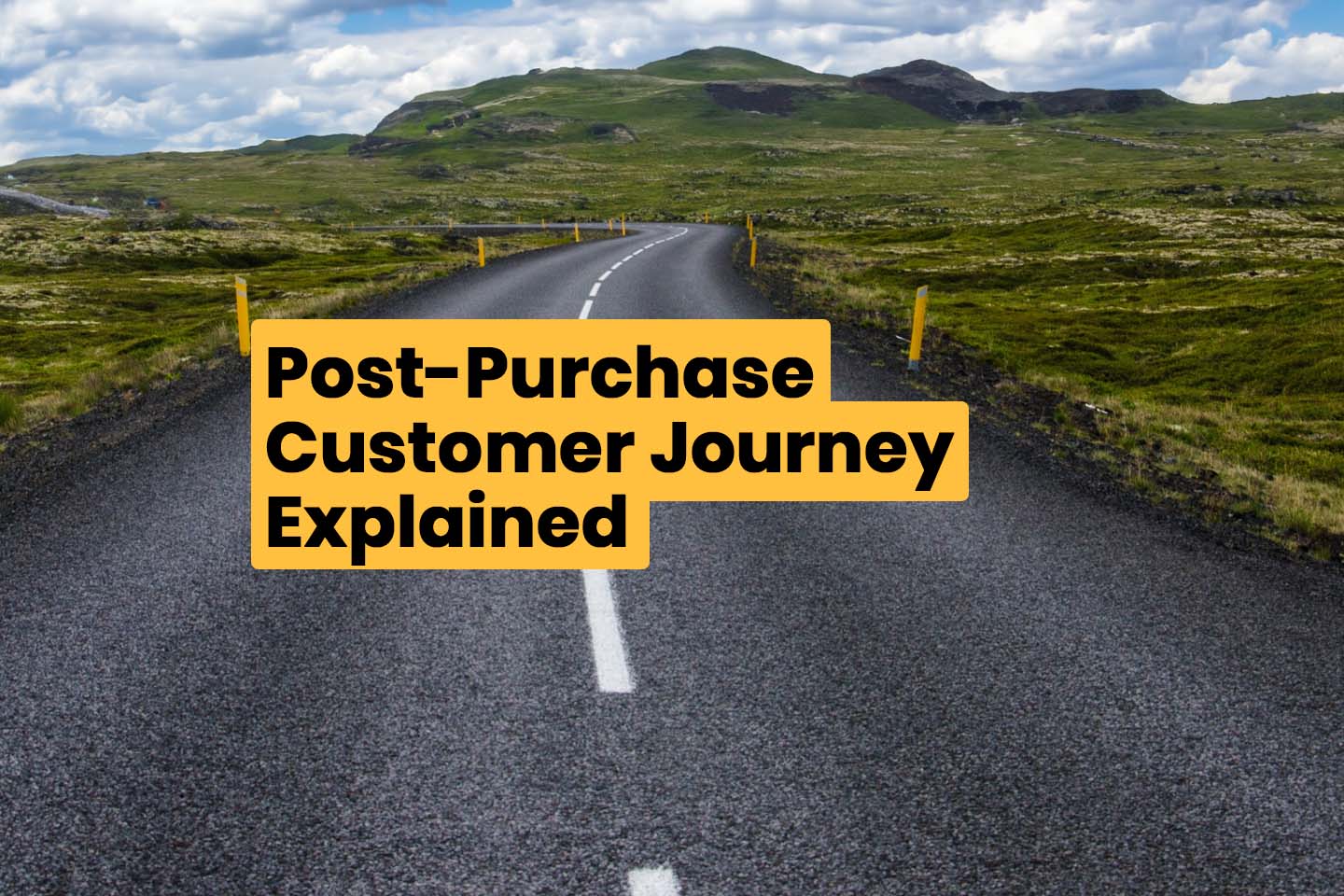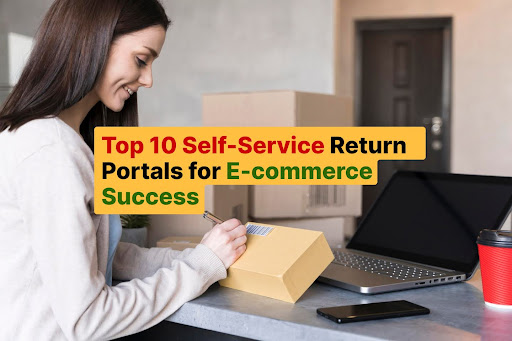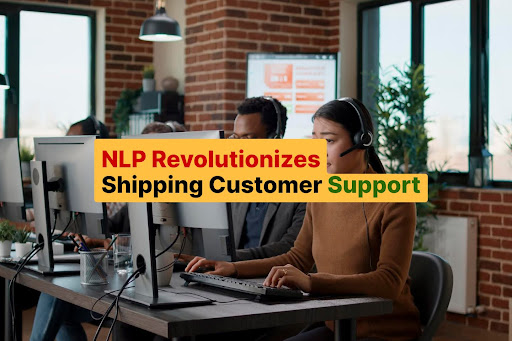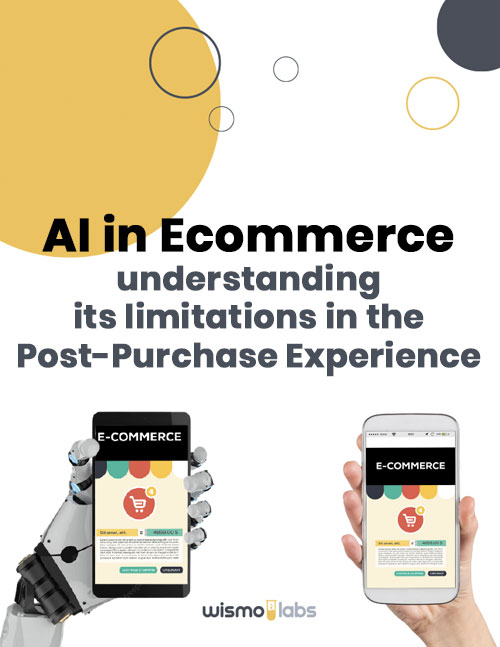This article is a part of a serie:
Ignite Loyalty: Post purchase customer journey explained
📦 Retailers guide to customer engagement during post-purchase journey.
In the bustling arena of e-commerce, the post purchase customer journey emerges as a pivotal phase that extends beyond the mere transactional experience.
As retailers, understanding and optimizing this journey is akin to turning a one-time buyer into a loyal patron.

What is post purchase customer journey and why it is important
The post purchase customer journey refers to the series of interactions and experiences that a customer goes through after making a purchase from an eCommerce retailer.
This journey unfolds the moment a customer completes a purchase, traversing through the realms of order delivery, product experience, and customer support, among others. Understanding and optimizing the post-purchase customer experience is critical for eCommerce retailers as it significantly impacts customer satisfaction, loyalty, repeat purchases, and ultimately, the lifetime value (LTV) of customers and overall revenue.

Our internal data at WISMOlabs reinforces the significance of post purchase customer journey phase: on average, about 88% of consumers desire notifications regarding the progress of their orders. Notably, the open rate of such notifications is 21% higher than other emails sent out by retailers, indicating a higher level of engagement during the post-purchase phase. By providing a seamless and positive post-purchase experience, retailers can foster stronger relationships with customers, encourage positive reviews and recommendations, and drive sustainable business growth.
Delivery Experience
The first footstep in post purchase customer journey map is the delivery experience. A prompt and accurate delivery not only meets the basic expectation but often leaves a lasting impression. The ease with which a customer can track their order, the clarity in communication regarding delivery timelines, and the actual adherence to these timelines are elements that color the customer’s perception.
The order delivery experience is a crucial segment that can significantly impact a customer’s perception and subsequent interactions with a retailer. This phase can be dissected into several stages, each with its unique challenges and opportunities for enhancement.
Order Confirmation

Upon the buyer’s departure from your site, order confirmation message initiates the post purchase customer journey.
Challenge: Customers expect immediate confirmation of their order, reflecting a seamless transaction. A delay or lack of confirmation can cause anxiety and doubt.
Improvement: Implementing automated systems to send instant confirmation emails or messages can alleviate concerns and enhance the customer’s confidence.
Leverage the order confirmation functionalities inherent in most ecommerce platforms like Shopify, BigCommerce, WooCommerce, Salesforce, Magento, and others. Ensure it’s enabled and integrate order tracking details to facilitate a smooth customer post-purchase experience throughout the entire after the purchase process while building your customer journey map.
Communication is key: Clearly articulating the next steps and processing time in your order confirmation message helps manage your customer’s expectations and paves the way for a satisfying post-purchase experience.
Order Processing

Challenge: Processing times can be a source of delay, and a lack of transparency during this phase can lead to customer frustration.
Improvement: Streamlining the processing workflow and keeping customers informed about the status can foster a sense of trust and patience.
Shipping and Delivery
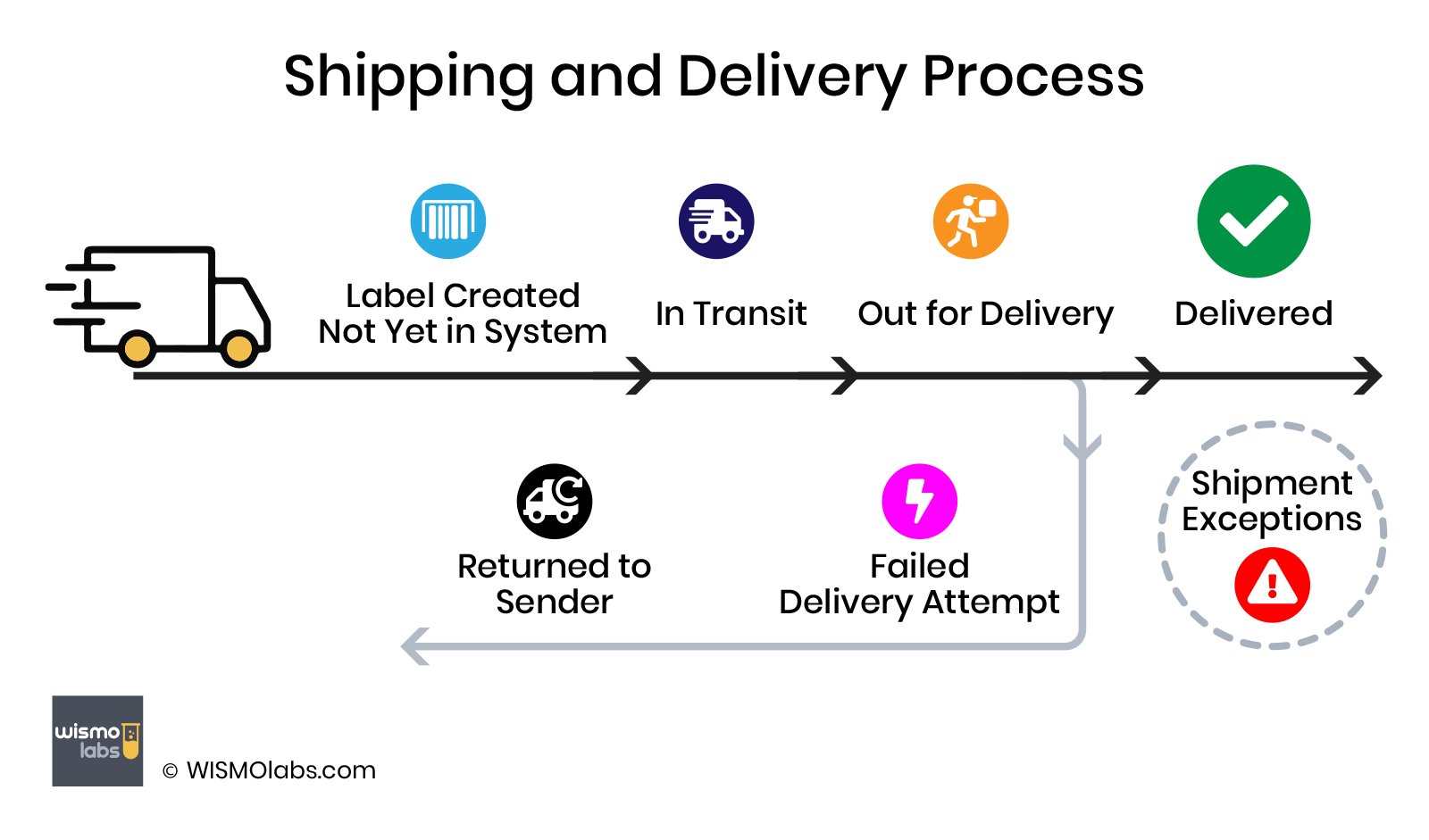
The Shipping and Delivery phase is a meticulous journey in itself, with each stage playing a critical role in fulfilling the customer’s expectations. Let’s delve into the intricacies of each stage from generating shipping label to delivering order into customers hands.
Label Created or Label Created Not Yet in System

The stage of “Label Created or Label Created Not Yet in System” is pivotal as it sets the stage for the ensuing delivery process.
When it occurs: This stage kicks off once an order is processed and is ready to be shipped. A shipping label is created to detail essential information like the destination address and tracking number.
Typical challenges: This stage is often marred by several challenges. A delay in system updates post label creation can trigger a tracking lag, leaving customers in the dark about the shipment status. Additionally, error messages on carrier tracking pages due to technical glitches further exacerbate the customer’s anxiety. The situation is aggravated when customers either do not receive or are unable to access the tracking information, causing further anxiety and uncertainty. Lastly, the lack of accurate delivery estimates can sow seeds of inconvenience and uncertainty, which might tint the overall customer experience unfavorably. Each of these challenges, if not addressed, can start the customer’s post purchase journey on a rocky note, and may lead to a ripple effect of dissatisfaction throughout the delivery process.
In Transit

The “In Transit” or “En-Route” stage is crucial as it signifies the journey of the order towards the customer, a phase ripe with anticipation.
When it occurs: This phase commences once the shipping carrier has received the order and is in the process of transporting it to the designated delivery address.
Typical challenges: The in-transit phase of post purchase customer journey is often strewn with hurdles like unexpected delays due to logistical issues or adverse weather conditions, which can postpone the delivery significantly. A common frustration arises from the lack of real-time tracking updates, leaving customers guessing about their order’s whereabouts. Misrouting or loss of packages is another daunting challenge that can further delay delivery and erode the customer’s trust. These challenges not only test the patience of customers but also the efficiency and reliability of the retailer’s logistics operations.
Out for Delivery

The “Out for Delivery” stage is a herald of the imminent arrival of the order, heightening the customer’s expectation.
When it occurs: This stage unfolds when the order is loaded onto the delivery vehicle and is en route to the customer’s address.
Typical challenges: Inaccurate delivery time estimates can lead to missed deliveries if customers are not available to receive the order. The lack of communication about the exact delivery time often leaves customers in a quandary, affecting their plans. Additionally, the inability of customers to change delivery details last minute if needed can lead to potential missed deliveries and dissatisfaction. These challenges demand a fine balance of precise communication, flexibility, and timely service to ensure a seamless delivery experience.
Failed Delivery Attempt

The “Failed Delivery Attempt” stage is a stumbling block that can drastically dampen the customer experience.
When it occurs: This stage arises when a delivery attempt is made, but the order could not be delivered, often due to the customer’s unavailability or incorrect address details.
Typical challenges: Inadequate communication regarding re-delivery or pickup options can leave customers feeling helpless. The lack of flexibility in rescheduling delivery attempts often adds to the customer’s frustration. Moreover, customer dissatisfaction may peak with multiple failed delivery attempts, which can be a result of either logistical hurdles or miscommunications. Addressing these challenges requires a blend of efficient communication, flexibility, and customer-centric solutions to ensure a satisfactory resolution.
Order Delivered

The “Order Delivered” stage is the culmination of the delivery part of post purchase customer journey, yet it holds the potential to either seal satisfaction or breed discontent.
When it occurs: This finale unfolds when the order successfully reaches the customer’s hands.
Typical challenges: Discrepancies like damaged goods, wrong items delivered, or deliveries made to incorrect locations can significantly tarnish the customer experience. Lack of immediate confirmation of delivery to the customer can cause uncertainty regarding the order status. Moreover, if the delivered items do not match the online descriptions or expectations, it could lead to dissatisfaction, returns, or negative reviews. Each of these challenges requires meticulous attention to ensure that the final touchpoint in the delivery journey leaves a lasting positive impression.
Shipment Exception

The “Shipment Exception” stage can be an unnerving period in the delivery process, often associated with unexpected obstacles that might disrupt the intended delivery timeline. This stage is typically marked by unforeseen events that are beyond the standard shipping and delivery process, potentially leading to delays or other delivery complications.
When it occurs: This stage materializes when the shipping carrier encounters an issue that prevents the package from following the normal delivery path or schedule. This can range from logistical complications to external factors like natural disasters.
Typical challenges:
- Unpredictability: Since shipment exceptions arise due to unforeseen circumstances, predicting them or having preemptive measures in place can be challenging. This unpredictability can sometimes result in longer delivery delays.
- Lack of Clarity: Carriers may provide vague reasons for the exception, leaving both the sender and recipient uncertain about the exact nature of the problem and the potential resolution.
- Customer Anxiety: Shipment exceptions often lead to customers being unsure about the status of their package and when, or if, they can expect its delivery.
- Operational Costs: Retailers or service providers might face increased operational costs due to rerouting, storage, or other logistical needs to address the exception.
- Communication Gaps: The delay in updating tracking systems or failure to promptly inform the customer of the exception can exacerbate feelings of mistrust or dissatisfaction.
Feedback on Delivery Experience

This phase occurs post-delivery of post purchase customer journey. During this phase, businesses have the opportunity to collect and act on customer feedback regarding their delivery experience. This feedback can be invaluable for identifying areas of improvement and enhancing future delivery experiences. By soliciting feedback and showing a proactive approach to implementing suggested improvements, businesses can foster a positive relationship with their customers, which in turn can lead to better delivery experiences in the future.
Challenge: Collecting and acting upon customer feedback regarding the delivery experience is often overlooked.
Improvement: Soliciting feedback post-delivery and demonstrating a proactive approach to implementing suggested improvements can foster a positive relationship and enhance future delivery experiences.
Return and Exchange

The return or exchange process typically occurs when a customer is dissatisfied with a purchased item due to reasons like defects, size issues, or simply a change of mind. This phase of post purchase customer journey can arise shortly after the delivery, once the customer has had a chance to review the product. It’s crucial for businesses to make this process as easy and clear as possible to maintain customer satisfaction and encourage future purchases.
The return or exchange process can also be triggered by buyer’s remorse, where a customer may feel regret over a purchase made impulsively or without thorough consideration. This feeling of remorse can prompt customers to return or exchange the item. Hence, having a straightforward and customer-friendly return or exchange process can alleviate some of the anxiety associated with buyer’s remorse, and potentially retain customers for future purchases. Learn how to e-commerce retailers can minimize buyer’s remorse.
Challenge: A cumbersome return or exchange process can deter customers from future purchases.
Improvement: Making the return or exchange process straightforward, clear, and customer-friendly is paramount.
Product experience

Following the delivery, the product experience takes center stage in a post purchase customer journey. Is the product meeting the expectations set by the online descriptions and images? Is it functioning as intended? These are critical junctures where a retailer’s commitment to quality and accuracy is put to the test.
Customer support

Now, let’s delve into customer support – where many retail narratives are won or lost. In situations where a product falls short the accessibility and efficiency of customer support become the linchpin of resolution. It’s the retailer’s empathetic ear and proactive issue resolution that often morphs a disgruntled buyer into a satisfied customer, showcasing the pivotal role of effective communication in enhancing the customer’s post purchase journey.
During pivotal post-purchase customer journey phases such as delivery, returns, and exchanges, deploying automated notifications can significantly alleviate the workload on a retailer’s customer support department, potentially reducing it by up to 90%. By proactively keeping customers well-informed throughout these stages, retailers can significantly minimize the instances where customers feel the need to reach out for updates, thereby fostering a more streamlined and satisfying post-purchase experience.
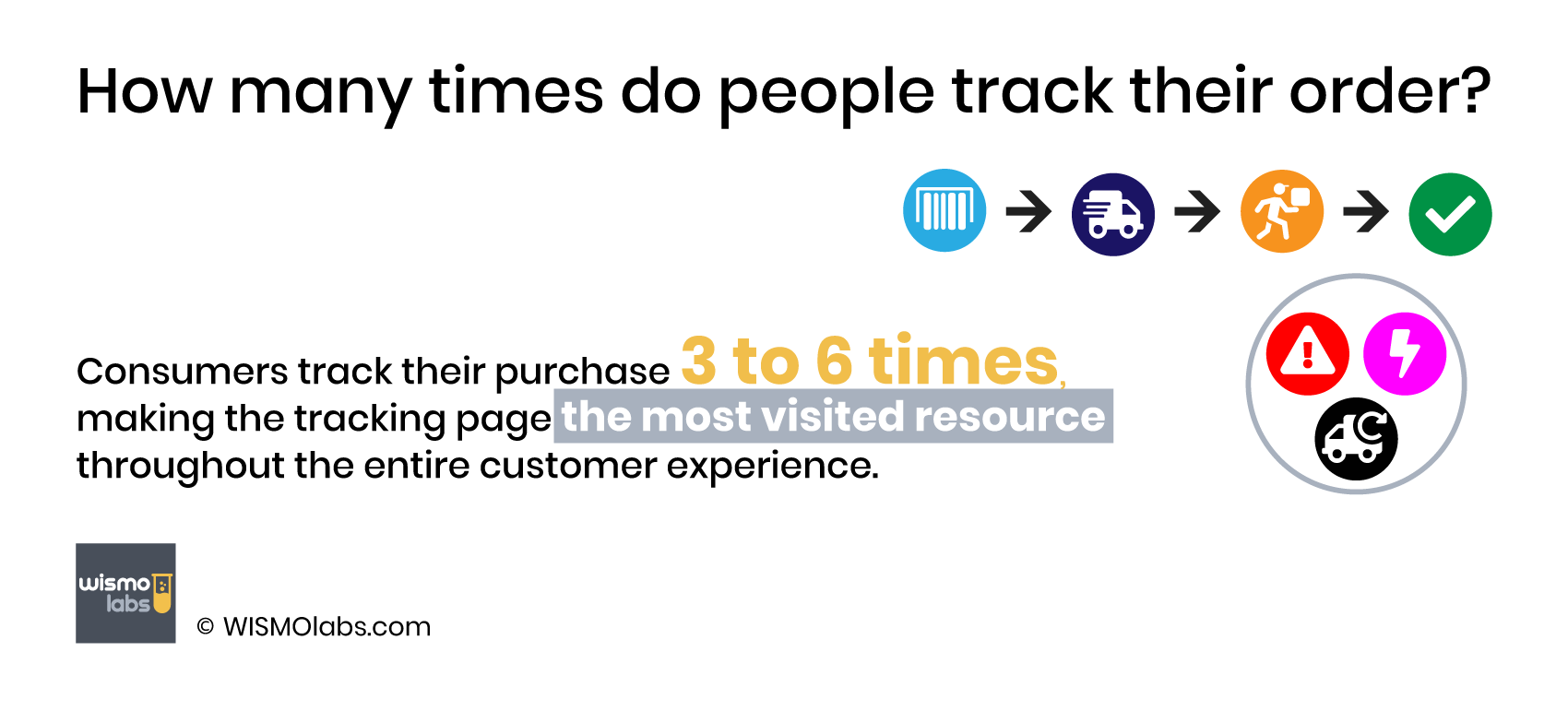
Situations may arise where a product doesn’t meet expectations or induces confusion. Here, the branded tracking portal pages shines. Our data shows the average buyer tracks their package 3-6 times throughout the post purchase customer journey. Being the most frequented pages with highest customer engagement during the entire shopper’s journey they can serve as an effective medium to educate customers about the awaiting products.
Feedback collection

Feedback collection is another chapter of post purchase customer journey. Encouraging customers to share their experiences, be it praise or constructive criticism, not only provides invaluable insights but also fosters a sense of community and engagement.
Conclusion: Post Purchase customer journey map
Technology and solutions has gracefully stepped in to automate and optimize many facets of the post purchase journey. Tools have emerged to streamline communication, solicit feedback, and provide real-time support, significantly enhancing the customer experience. WISMOlabs, for instance, subtly epitomizes this transformation. Through its innovative solutions, many retailers have successfully enriched their post purchase customer journey. The tales of reduced customer anxiety, enhanced communication, and overall elevated customer satisfaction echo the potential of integrating such tools.
By meticulously crafting the post purchase customer journey, retailers not only stand to foster stronger relationships but also to propel their brand into a realm of enhanced credibility and customer loyalty. In the grand tapestry of e-commerce, this journey isn’t a mere transactional endpoint, but a gateway to enduring customer relationships and sustained business growth.
This article is a part of a serie:
Ignite Loyalty: Post purchase customer journey explained
FAQ
What is the Post-Purchase Customer Journey?
Post Purchase Customer Journey is the series of interactions and experiences a customer has after purchasing from an eCommerce retailer, including order delivery, product experience, and customer support. This journey impacts customer satisfaction, loyalty, and repeat purchases.
What is the Importance of Delivery Experience?
Delivery experience is the first step in this post purchase customer journey. Prompt, accurate delivery, ease of tracking, clear communication, and adherence to delivery timelines are crucial for a positive perception of eCommerce retailer brand.
How Crucial is Order and Shipping Confirmations?
Immediate order and shipping confirmation is essential. Delays or lack of confirmation can cause anxiety. Automated systems for instant confirmation emails or messages can enhance customer confidence.
What Challenges Arise During Order Processing?
Processing times can cause delays and frustration in customers after the purchase. Transparency and streamlined workflow can foster trust and patience.
What are the Stages of Shipping and Delivery?
This includes several stages like label creation, in-transit, out for delivery, failed delivery attempts, and exceptions. Each stage has its unique challenges, requiring clear communication and efficient handling.
How Important is Feedback on Delivery Experience?
Collecting and acting upon customer feedback post-delivery is vital for identifying improvement areas and enhancing future experiences.
What Should Retailers Know About Returns and Exchanges?
A straightforward, clear, and customer-friendly return or exchange process is essential, especially when dealing with buyer’s remorse.
What Constitutes Product Experience?
Post-delivery, assessing if the product meets online descriptions and functions as intended is critical.
How Significant is Customer Support?
Efficient customer support is crucial, especially in cases where the product doesn’t meet expectations. Automated notifications during delivery, returns, and exchanges can reduce customer support workload by up to 90%.
Why is Feedback Collection Important?
Encouraging customers to share their experience fosters a sense of community and provides valuable insights to improve the post purchase customer journey.
